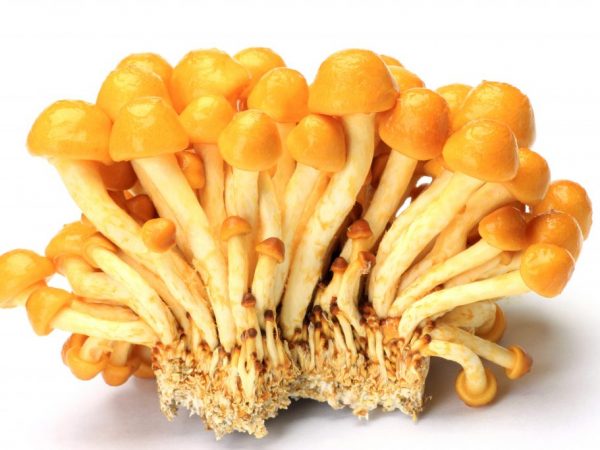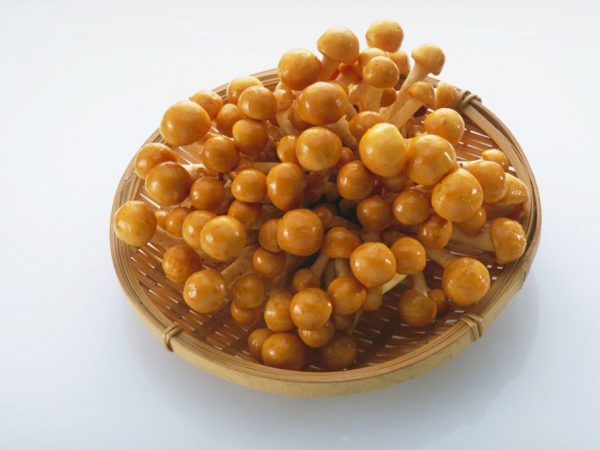Edible scaly mushroom
The scaly mushroom (nameko) is an edible representative of the Strophariaceous family of the order Agaricaceae from the genus Foliot. In appearance, they are similar to ordinary mushrooms, differing from the latter in smaller sizes. They are widely used in Japanese cuisine.

Edible scaly mushroom
Botanical characteristics of the genus
Scales include several representatives:
- ordinary (fleecy);
- edible (hint);
- fiery;
- destructive;
- alder;
- yellowing;
- golden yellow;
- red;
- gummy, etc.
Most of them belong to the group of conditionally edible mushrooms. Many have false counterparts similar in description, often with a rich yellow color. Common, destructive, and fiery can be used for food after preliminary heat treatment. Nameko is an edible species known in China and Japan.
Description
According to the description of the type, edible scaly or a hint of a mushroom, the cap on average reaches a diameter of just over 1 cm. The appearance of the caps of young mushrooms resembles brown or orange buttons.
The cap surface is covered with a jelly-like substance, similar to mucus, which sharply distinguishes the hint from the usual European honey agarics, in which the cap surface is fleecy.
From Japanese the word "nameko" is translated as "slippery mushroom". In the Russian language there are synonyms - mushroom and foliot nameko.
The mushroom pulp is dense, white. The leg reaches a height of 5 cm.
This species belongs to basidiomycetes, multiplying by means of spore powder formed in clavate structures (basidia). According to the botanical description, it is a heterotrophic organism that feeds on ready-made organic substances that are formed as a result of destructive processes of decay or saprophyte.
Distribution and cultivation
Under natural conditions, allusions are found in mixed forest areas, where increased moisture levels are noted, reaching 90-95%. Referring to saprophytes, they prefer stumps and places near the roots of fallen trees. They grow in large colonies of several mushroom legs, growing from a single base.
For culinary purposes, edible flakes are grown artificially. When breeding under artificial conditions on sawdust and substrates obtained from broad-leaved species, mainly beech, special shelters and the mandatory use of air humidifiers are required.
Composition and benefits of a hint

Mushrooms contain many beneficial trace elements
The calorie content of a hint in terms of 100 g is only 22 kcal, and the mushroom also has the following characteristics:
- up to 3.1 g of proteins;
- up to 0.34 g of fat;
- up to 3.26 g of carbohydrates;
- up to 1.0 g of dietary fiber;
- up to 0.85 g of ash substances;
- up to 91.5 g of water.
Vitamin and mineral composition includes (in mg) the following:
- potassium - 318;
- phosphorus - 85;
- magnesium - 9.0;
- sodium - 5;
- nicotinic acid - 3.6;
- calcium - 3.0;
- ascorbic acid - 2.1;
- pantothenic acid - 1.5;
- iron - 0.5;
- zinc - 0.5;
- riboflavin - 0.4;
- copper - 0.32;
- vitamin b6– 0,1;
- vitamin E - 0.1;
- thiamine - 0.08;
- manganese - 0.05;
- as well as in small amounts (less than 1 mg) selenium, vitamins K1, D, B12.
The benefits of a hint for human health are the following elements contained in the composition:
- campesterol (a compound found in phytosterols);
- polyunsaturated acids;
- saturated acids;
- amino acids:
- glutamic acid;
- valine;
- alanine;
- aspartic acid;
- threonine;
- leucine;
- lysine;
- glycine;
- serine;
- isoleucine;
- phenylalanine;
- arginine;
- proline;
- histidine;
- tryptophan;
- tyrosine;
- methionine;
- cystine.
dzs_videogallery]
Practical use
Edible flake has found wide application in Chinese and Japanese cuisine many years ago as an ingredient used fresh and pickled in salads. Often included in the traditional miso soup.
The mushroom has a sweetish taste and a jelly-like structure. During the heat treatment, the oily jelly on the mushroom surface dissolves.
Irina Selyutina (Biologist):
On the territory of Russia to buy a fresh hint, something from a number of fantasy. And all because they are stored for a very short time. If you are still lucky, and you "got" to fresh mushrooms in the supermarket, then when choosing them do not forget:
- there should not be the slightest damage on the caps;
- the surface should have a uniform orange-brown color.
Consider. You can store fresh hints only in the refrigerator, it is advisable to eat them in 1-2 days.
In Russian stores, hints are usually received in pickled form (tin or glass jars) and are sold under the name "Japanese honey mushrooms". Store pickled hints at a temperature not exceeding + 15 ℃ away from a source of moisture and heat.
Mushrooms are used in Chinese traditional medicine to stop the growth of cancer cells, including against sarcoma. Tinctures made on their basis are a blood thinner, therefore they are recommended in the treatment of thrombophlebitis. Indicated for diabetics, because lower the percentage of blood sugar.
Conclusion
A type of flake or a hint of mushroom is edible. Grows in well-hydrated mixed forests. Artificially grown for culinary purposes. It has a number of useful properties and is used in traditional medicine. There are species related to it that are conditionally edible: common scaly (fleecy), fire, herbal, etc.



